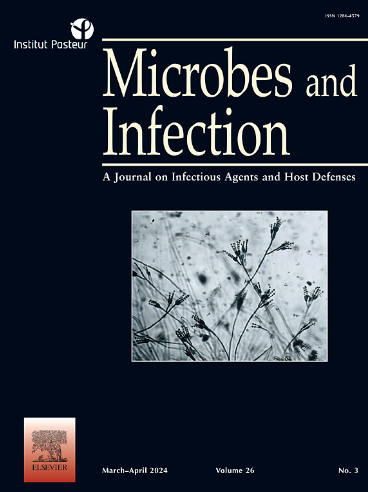Lineage classification and selective site identification of Orthoebolavirus zairense
IF 2.7
4区 医学
Q3 IMMUNOLOGY
引用次数: 0
Abstract
As the high pathogenic species of Filoviridae virus family, Orthoebolavirus zairense (EBOV) shows frequent outbreaks in human in recently years since its first emerging in 1976 in Democratic Republic of the Congo (COD), bringing ongoing risks and burden on public health safety. Here, the phylogenetic relationship among major outbreaks was analyzed. The results showed that EBOV isolates could be divided into four lineages according to spatial and temporal epidemics. Then, the positive selection sites (PSSs) were detected on all proteins of the EBOV, exhibiting lineage characteristic. Particularly, sites in GP and VP24 were identified to be significantly under positive selection, and partial of which were maintained in the latest isolates in 2021. GP and L were found to have high variability between lineages. Substitutions including F443L and F443S in GP, as well as F1610L and I1951V in L could be characteristic of the two large outbreaks in COD (2018) and West Africa (2014), respectively. Further, substitutions of significant PSSs in VP24 and L proteins were visualized for analysis of structural changes, which may affect EBOV pathogenesis. In summary, our results gains insights in genetic characteristic and adaptive evolution of EBOV, which could facilitate gene functional research against EBOV.
Orthoebolavirus zairense 的品系分类和选择性位点鉴定。
作为丝状病毒科(Filoviridae virus)病毒属中的高致病性病毒,刚果(金)直乙脑病毒(Orthoebolavirus zairense,EBOV)自1976年首次在刚果(金)出现以来,近年来频繁在人体内暴发,给公共卫生安全带来了持续的风险和负担。本文分析了主要疫情之间的系统发育关系。结果表明,EBOV分离物可根据流行的空间和时间分为四个系。然后,在EBOV的所有蛋白质上都检测到了正选择位点(PSS),表现出了系谱特征。特别是在GP和VP24上发现了明显的正选择位点,其中部分位点在2021年的最新分离株中得以保留。研究发现,GP 和 L 在不同品系之间具有很高的变异性。包括 GP 中的 F443L 和 F443S 以及 L 中的 F1610L 和 I1951V 在内的替换可能分别是 COD(2018 年)和西非(2014 年)两次大规模爆发的特征。此外,VP24和L蛋白中重要PSS的替代被可视化,以分析可能影响EBOV致病机理的结构变化。总之,我们的研究结果深入揭示了EBOV的遗传特征和适应性进化,有助于开展针对EBOV的基因功能研究。
本文章由计算机程序翻译,如有差异,请以英文原文为准。
求助全文
约1分钟内获得全文
求助全文
来源期刊

Microbes and Infection
医学-病毒学
CiteScore
12.60
自引率
1.70%
发文量
90
审稿时长
40 days
期刊介绍:
Microbes and Infection publishes 10 peer-reviewed issues per year in all fields of infection and immunity, covering the different levels of host-microbe interactions, and in particular:
the molecular biology and cell biology of the crosstalk between hosts (human and model organisms) and microbes (viruses, bacteria, parasites and fungi), including molecular virulence and evasion mechanisms.
the immune response to infection, including pathogenesis and host susceptibility.
emerging human infectious diseases.
systems immunology.
molecular epidemiology/genetics of host pathogen interactions.
microbiota and host "interactions".
vaccine development, including novel strategies and adjuvants.
Clinical studies, accounts of clinical trials and biomarker studies in infectious diseases are within the scope of the journal.
Microbes and Infection publishes articles on human pathogens or pathogens of model systems. However, articles on other microbes can be published if they contribute to our understanding of basic mechanisms of host-pathogen interactions. Purely descriptive and preliminary studies are discouraged.
 求助内容:
求助内容: 应助结果提醒方式:
应助结果提醒方式:


